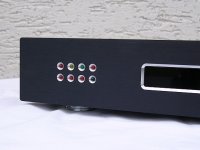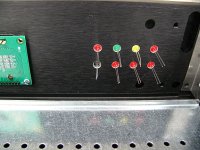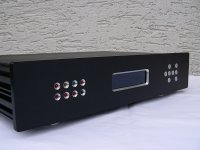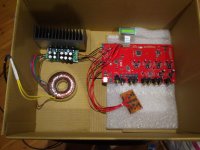Thanks all for your input.
A bit of clarification:
No Ake, this is supported in hardware but not yet in firmware.
Yes, this is a somehow similar request to Jiri's. What we need to decide now is what chip we want to support.
What remote are you using? With all my remotes i can control the volume in dB increments.
Is that really required? I know we talked about it a couple of times - but it's a lot of work for just a display. The complication comes from the fact that OLED has no backlight and no contrast adjustment, so some parts in the menu wouldn't be relevant.
I could rework that so that these irrelevant menu items are out when you plug a OLED.
Then adapt the parallel protocol to support OLED.
Then add a feature so that the user can tell Najda whether he intends to use a regular LCD or the OLED.
Then what happens if the user declares the wrong display type? (Probably nothing on the display so I would need to set sth in the control application to 'reset' the display type)
Well that's what I said: a lot of work for a display. So is that really requested?
Best,
Nick
A bit of clarification:
Have one connected to the expansion port right now..
Thought it was supported..
No Ake, this is supported in hardware but not yet in firmware.
it would be nice to have the possibility to control external DAC (SABRE ?) volume through i2c port
Yes, this is a somehow similar request to Jiri's. What we need to decide now is what chip we want to support.
12. Change remote control volume steps from 3 dB to 1 or 2. (or user selectable)
What remote are you using? With all my remotes i can control the volume in dB increments.
Please also consider adding user configurability for LCD (HD44780) vs OLED (WS0010) modules.
Is that really required? I know we talked about it a couple of times - but it's a lot of work for just a display. The complication comes from the fact that OLED has no backlight and no contrast adjustment, so some parts in the menu wouldn't be relevant.
I could rework that so that these irrelevant menu items are out when you plug a OLED.
Then adapt the parallel protocol to support OLED.
Then add a feature so that the user can tell Najda whether he intends to use a regular LCD or the OLED.
Then what happens if the user declares the wrong display type? (Probably nothing on the display so I would need to set sth in the control application to 'reset' the display type)
Well that's what I said: a lot of work for a display. So is that really requested?
Best,
Nick
Nick, I don't know if my suggestion is the best way to go about it. I am quite keen on OLEDs. In fact, I am somewhat surprised that there has not been other requests to get Najda compatible with OLED displays.
My motivations for wanting to use OLED are as follows:
WS0010 driver is supposed to be HD44780-compatible, but it does require some initialisation code to set it up. Hopefully, that setup code will be transparent to LCDs, and so perhaps LCDs can work in "OLED mode" (I don't know for sure; I'm just hoping!). I would not mind if the LCD functions stay while OLED is installed; one could just ignore them - or prefix their descriptions with "LCD".
I realise that this request is lower down the priority list, but do give it some honest consideration. I think the look of LCDs are quite dated and out of place in a great product such as Najda.
My motivations for wanting to use OLED are as follows:
- High clarity, high contrast display
- Wide viewing angle (no need for contrast adjust)
- LCD has a wide variance in display quality between model offerings, whereas OLED is just good by default.
WS0010 driver is supposed to be HD44780-compatible, but it does require some initialisation code to set it up. Hopefully, that setup code will be transparent to LCDs, and so perhaps LCDs can work in "OLED mode" (I don't know for sure; I'm just hoping!). I would not mind if the LCD functions stay while OLED is installed; one could just ignore them - or prefix their descriptions with "LCD".
I realise that this request is lower down the priority list, but do give it some honest consideration. I think the look of LCDs are quite dated and out of place in a great product such as Najda.
Last edited:
1. Allow enabling/disabling processing channels in order to save resources when the user needs less than 10 outputs.
2. Channel pairing/linking: what you change for one channel will also affect the paired channel.
3. New setup: FIR/IIR mix.
4. Allow renaming of sources (LCD).
5. Implement support for expansion board.
6. Decimation in FIR.
7. Support for external master clock.
8. Keyboard shortcuts for volume change when connected.
9. Include input response in output graph.
10. Check what's going on with Bass/Treble (clip led and phase)
Hi! I would vote for 1, 3 and 6! Apart from that, support for OLED would be great. And the possibility of controlling the volume for an external dac (Sabre). And of course a mac-verision of NUC.
Best regards,
Mattias
WS0010 driver is supposed to be HD44780-compatible, but it does require some initialisation code to set it up. Hopefully, that setup code will be transparent to LCDs, and so perhaps LCDs can work in "OLED mode" (I don't know for sure; I'm just hoping!). I would not mind if the LCD functions stay while OLED is installed; one could just ignore them - or prefix their descriptions with "LCD".
Hi Shaun,
Indeed that would make things simpler if we could have a common driver for both HD44780 and WS0010.
OK, I'm not ruling out support for OLED. Just there are some more urgent tasks.
Hi Nick,
Regarding the volume control chip - why not to stick with CS3318? It is already used so it should not be too difficult to implement controlling of 2nd chip off the board.
Yes. That would be the easiest for me.
And the possibility of controlling the volume for an external dac (Sabre)
There's been several requests for controlling ESSes. The trouble is that these guys don't make their datasheet public - god knows why.
1. Allow enabling/disabling processing channels in order to save resources when the user needs less than 10 outputs.
3. New setup: FIR/IIR mix.
6. Decimation in FIR.
I will also vote for 1, 3, 6 in that order.
Later on it, would be nice to be able to use external DACs with external volume control.
OLEDs
I agree completely with you! It would be a feature I also would like to see in Najda.

Best Regards
Sigi
Nick, I don't know if my suggestion is the best way to go about it. I am quite keen on OLEDs. In fact, I am somewhat surprised that there has not been other request on OLEDs
I realise that this request is lower down the priority list, but do give it some honest consideration. I think the look of LCDs are quite dated and out of place in a great product such as Najda.
I agree completely with you! It would be a feature I also would like to see in Najda.
Best Regards
Sigi
There's been several requests for controlling ESSes. The trouble is that these guys don't make their datasheet public - god knows why.
HiFiDUNIO's site has lots of information about ESS DACs (9018). Code for external volume control have been provided by clever bods - this is geared up for Ardruino. I have no idea how useful this is for the chips on Najda but just in case you haven't seen it, here's a link
Arduino, Code | H i F i D U I N O
I've been away from this for a while, but been using Najda regularly
Getting an itch that needs scratching... I wonder if folk have changed OP amps from the standard and if so to what - best bang for buck? - The supplied ones were chosen for just that - bang for buck but...
Getting an itch that needs scratching... I wonder if folk have changed OP amps from the standard and if so to what - best bang for buck? - The supplied ones were chosen for just that - bang for buck but...
Last edited:
Getting an itch that needs scratching... I wonder if folk have changed OP amps from the standard and if so to what - best bang for buck? - The supplied ones were chosen for just that - bang for buck but...
I'm running OPA2132 throughout. Seems good bang for buck to me. Bass seems tighter with these compared to original supplied.
I'd also be interested to hear what others have tried.
Najda seems a perfect tool to compare opamps due to multiple outputs and socketed chips, with potential to compare opamps between channels.
Thanks all for your feedback.
The next release will feature:
- Enabling/Disabling of processing channels
- FIR/IIR mix
- Channel pairing
- Input processing optionally included in output graph
- Renaming of sources on LCD
- Possibly more
The remaining items will be included in a further release.
On another note, there's the expansion board. The original idea was to add 2 more analogue outputs for those who are into 2x5 ways systems.
My problem is that there's no economically viable solution for this. Indeed, a stereo volume chip that can do the same on 2 channels as the CS3318 on 8 channels, is about as expensive as the CS3318...
I'm thinking of extending the capabilities of the expansion board in order to justify the cost:
- 2 analogue outs with volume
- 2 analogue ins with adjustable input level
- 4 volume controls for external channels.
How does that sound?
Thanks for that, it's surely going to prove useful at some point.
We could do that, of course (provided there's a way to integrate this nicely in the app). In the meantime, you can use the custom biquads for that.
Thanks Bengt
The next release will feature:
- Enabling/Disabling of processing channels
- FIR/IIR mix
- Channel pairing
- Input processing optionally included in output graph
- Renaming of sources on LCD
- Possibly more
The remaining items will be included in a further release.
On another note, there's the expansion board. The original idea was to add 2 more analogue outputs for those who are into 2x5 ways systems.
My problem is that there's no economically viable solution for this. Indeed, a stereo volume chip that can do the same on 2 channels as the CS3318 on 8 channels, is about as expensive as the CS3318...
I'm thinking of extending the capabilities of the expansion board in order to justify the cost:
- 2 analogue outs with volume
- 2 analogue ins with adjustable input level
- 4 volume controls for external channels.
How does that sound?
HiFiDUNIO's site has lots of information about ESS DACs (9018). Code for external volume control have been provided by clever bods - this is geared up for Ardruino. I have no idea how useful this is for the chips on Najda but just in case you haven't seen it, here's a link
Arduino, Code | H i F i D U I N O
Thanks for that, it's surely going to prove useful at some point.
On another topic. Would it be possible to ad a Linkwitz transform function to the eq section ?
We could do that, of course (provided there's a way to integrate this nicely in the app). In the meantime, you can use the custom biquads for that.
Buy the way, it sounds great
Thanks Bengt
I'm just getting my Nadja up and running (PSU connected last night!), but this list looks quite good to me. I'm definitely interested in more analogue ins (already need phono + home theatre) and the idea of having the volume control available for external channels is nifty however I'm not sure of the application for 4 channels - if there was some way to use this board to pump an external DAC (Buffalo!!!) back through the Nadja's volume control it'd be fantastic.I'm thinking of extending the capabilities of the expansion board in order to justify the cost:
- 2 analogue outs with volume
- 2 analogue ins with adjustable input level
- 4 volume controls for external channels.
How does that sound?
Thanks all for your feedback.
I'm thinking of extending the capabilities of the expansion board in order to justify the cost:
- 2 analogue outs with volume
- 2 analogue ins with adjustable input level
- 4 volume controls for external channels.
Hi Nick,
I would be happy with the expansion board. It would cover my needs for addtional volume control for home theater and extra analogue input is always handy.
Hello,
I believe it is may be justified in case of bad signal quality (high level of jitter), but it is better to avoid to use this function in the rest of the cases.
In case it is a question of supported sample rates by the used processor, again, it may be more flexible to set up the needed sample rate using PC resources.
It would be nice if it is possible to turn off this feature. We can use I2S output with external clock in the future, but once the mentioned feature is active, the signal is degraded accordingly in digital domain before processing.Digital signals pass through the onboard sample rate converter so that there's no need worrying about the source's sampling rate.
I believe it is may be justified in case of bad signal quality (high level of jitter), but it is better to avoid to use this function in the rest of the cases.
In case it is a question of supported sample rates by the used processor, again, it may be more flexible to set up the needed sample rate using PC resources.
Hi Nick
I tried this IR-Receiver: OS-OPTO OS-0038N > Datasheet
Because it is so easy to install as an LED. It's the last one in the row of LEDs. But it does not work.
Any chance to make it work?
The Vishay's work. But are much more complicated to install.
Best regards,
Bruno
I tried this IR-Receiver: OS-OPTO OS-0038N > Datasheet
Because it is so easy to install as an LED. It's the last one in the row of LEDs. But it does not work.
Any chance to make it work?
The Vishay's work. But are much more complicated to install.
Best regards,
Bruno
Attachments
Last edited:
Hey look, i'm quoting myselfI'm not sure of the application for 4 channels
In other news, a photo of my prototype! I'm using a (DIY) linear power supply from JLM Audio and oversized toroidal from Tortech. Both Australian companies and I'd happily recommend this PSU to anyone who wants to run a linear - the JLM (either power station or better kraftwerk) PSU is designed for microphone pre's, so it should be quiet, gives 5 rails (3 +pve, 2-ve) and voltage is set via a trimpots - I'll be using the remaining rails for other random junk that'll appear in the box with my Nadja.
Attachments
- Home
- Source & Line
- Digital Line Level
- DSP Xover project (part 2)



